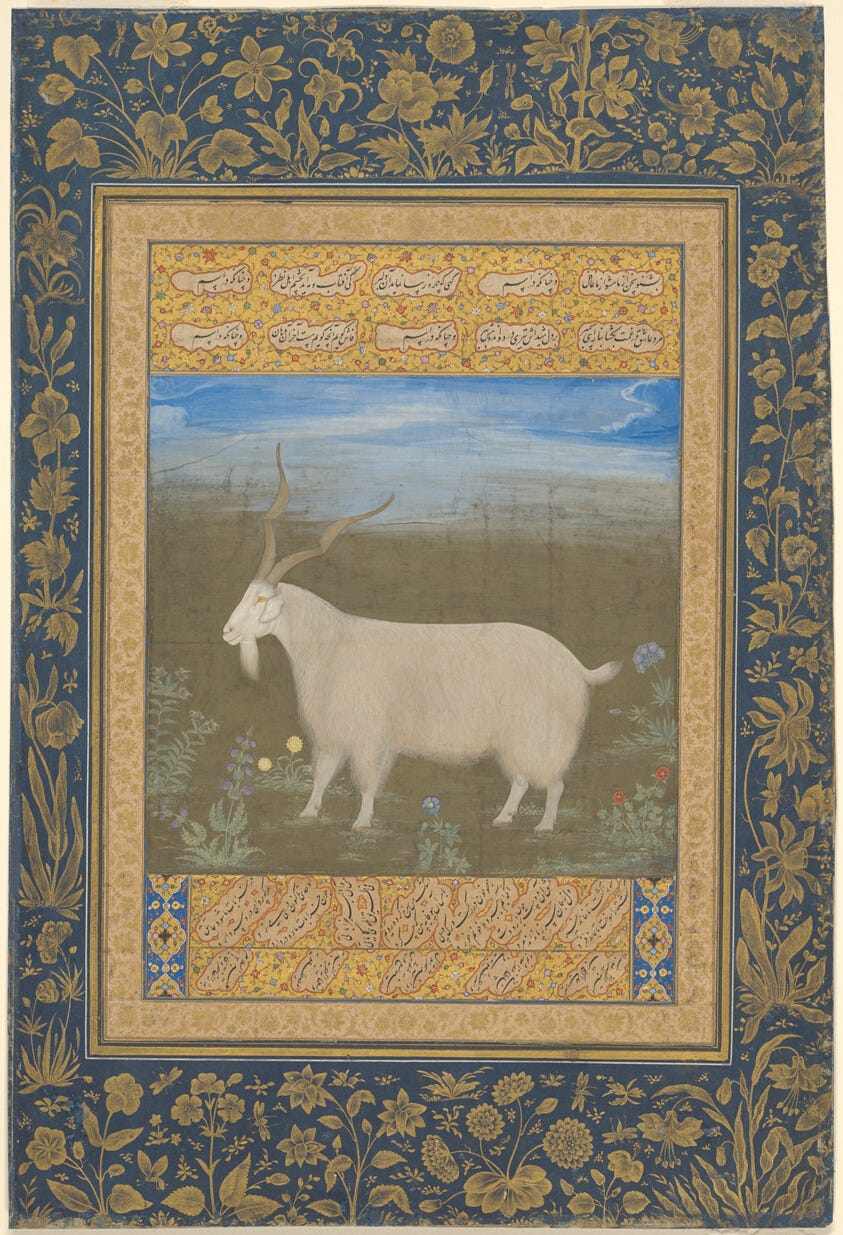#73. GOAT / CABRA
A wholly new relationship with these 'horrors' and 'moral depravities' and 'madness' / una nueva relación con esos «horrores», «depravaciones morales» y «locura»
Mist at dawn:
people passing by, like
in a painted dream.
Yosa Buson
GOAT
Astute, temperamental and difficult to tame. Darkness and liberated passions. For the Greeks, the goat was inseparable from lightning, Zeus was raised by the Amalthea goat and the star Capella (the goat) in the constellation of Auriga announced storm and rain. According to legend, goats possessed by a crazy dance guided the ancient Greeks towards vapors that came out of the earth's entrails and there they formed the Oracle of Delphi. The Greek god Pan was a wild and luxurious billy goat, stirring up insatiable desires and his screams gave the name to panic attacks. It must be borne in mind that Pan's terrifying cry allowed the Olympic gods to defeat Kronos and the Titans in the great battle of the origins. Pan is the divinity of shepherds, is found in riverside forests and creeks, is tied to nature renewal cycles and likes naps. Pan is part of the Dionysian imaginary along with satyrs, maenads and nymphs. We have to keep a watchful eye on the unbridled goat, it can lead to ruin or it can fill us with energy. The billy goat also appear as the image of the devil and it is a central element of the satanic covens and rituals. Christian iconography usually represents Satan in the form of a black billy goat. In India, the billy goat is a divine animal identified with the fire god Agni, and embodies the regenerative life power. Saints and demons, goats and billy goats are a universal symbol of instinctive, vivifying and dangerous forces.
“We shall not be able to find our way back to harmony with nature through the study of it alone. Though our major concern is ecological, it cannot be solved through ecology alone. […] The re-education would have to begin at least partly from Pan's point of view, for after all it is his world that we are so intensely worried about. But Pan's world includes masturbation, rape, panic, convulsions and nightmares. The re-education of the citizen in relation to nature means nothing less than a wholly new relationship with these 'horrors' and 'moral depravities' and 'madness' which are part of the instinctual life of the citizen's soul.”
Pan and the nightmare by James Hillman
Boirina a l’alba:
gent que passa, com
en un somni pintat.
Yosa Buson
CABRA
Astuta, temperamental i difícil de domar. Foscor i passions alliberades. Capritx ve del mot llatí capra. Pels grecs la cabra era inseparable del llampec, Zeus va ser criat per la cabra Amaltea i l’estrella Capella —la cabra—, a la constel·lació de l’Auriga, anunciava tempesta i pluges. Segons la llegenda, unes cabres posseïdes per un ball embogit van guiar els antics grecs cap a uns vapors que sortien de les entranyes de la terra i allà van constituir-hi l’oracle de Delfos. El déu grec Pan era un boc salvatge i luxuriós, despertava els desitjos insaciables i els seus crits van donar nom als atacs de pànic. Cal tenir present que el terrorífic crit de Pan va permetre que els déus olímpics derrotessin a Cronos i als Titans en la gran batalla dels orígens. Pan és la divinitat dels pastors, se’l troba als boscos de ribera i als rierols, va lligat als cicles de renovació de la naturalesa i li agraden les migdiades. Pan forma part de l’imaginari dionisíac juntament amb els sàtirs, les mènades i les nimfes. Cal vigilar amb el descontrol de la cabra desbocada, pot dur-nos a la ruïna o pot omplir-nos d’energia. Els bocs també apareixen com la imatge del diable i són un element central dels aquelarres i rituals satànics. La iconografia cristiana sol representar a Satanàs en forma de boc negre. A la Índia, el boc és un animal diví que s’identifica amb el déu del foc, Agni, i encarna l’impuls vital regenerador. Santificats i demonitzats, les cabres i els bocs són un símbol universal de la força instintiva, vivificant i perillosa.
“No podremos volver a estar en armonía con la naturaleza si nos limitamos simplemente a estudiarla. Y aunque la mayor preocupación de nuestros días sea ecológica, la ecología por sí misma no es suficiente. […] La reeducación debería comenzar, al menos en parte, desde el punto de vista de Pan, pues, después de todo, lo que tanto nos preocupa es su mundo natural. Pero el mundo de Pan incluye masturbación, violación, pánico, convulsiones y pesadillas. La reeducación del ciudadano en relación con la naturaleza implica nada más y nada menos que una nueva relación con esos «horrores», «depravaciones morales» y «locura» que forman parte de la vida instintiva del alma del ciudadano. Si Pan causa la locura, entonces él mismo la cura. Lo semejante cura lo semejante”
Pan y la pesadilla de James Hillman













